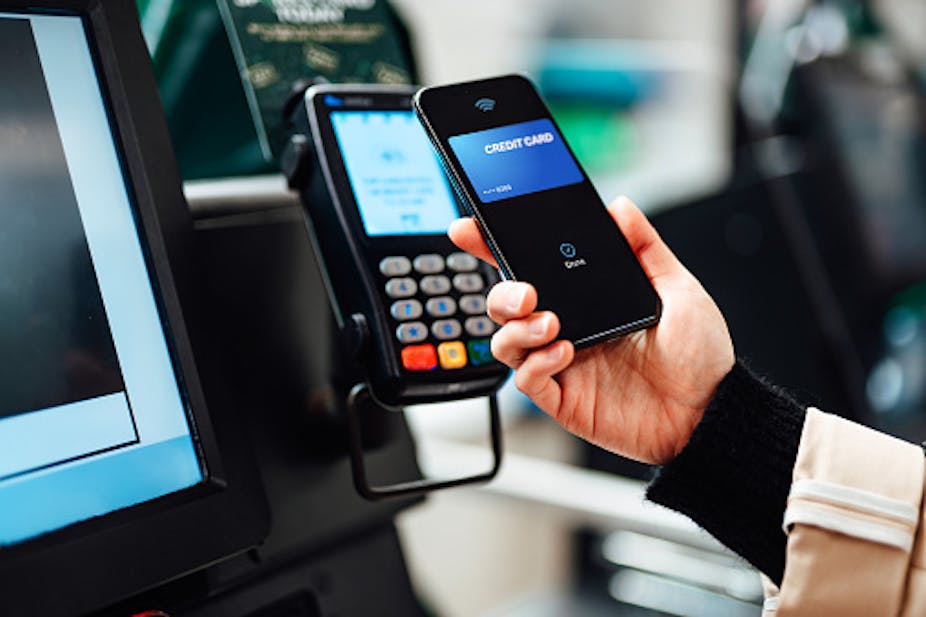Across countries in Africa, only 33% of adults have an account at a bank or another financial institution. Among the women, this rate is only 27%.
Financial services like accounts, credit cards and retirement plans allow people to protect their savings, earn interest, borrow for big expenses like a house or medical bills, and even start their own businesses. This is why financial inclusion is mentioned in eight out of 17 of the Sustainable Development Goals.
But opening and maintaining these kinds of accounts can be difficult when banks are difficult to reach. To solve this, some have proposed using digital technologies to reach the “unbanked”.
Services like mobile money, which allow people to use their mobile phones to make or receive payments, have become quite popular. In recent years, more than 157 mobile money operators like M-Pesa and Orange have taken off across the African continent.
These have become even more popular for contactless communication during the COVID-19 pandemic. In response to the pandemic and lockdowns, the use of mobile money increased more than three times in Rwanda. Many governments in sub-Saharan Africa waived mobile money fees and increased transaction limits to encourage use.
This means people who cannot use these digital services are being left behind as the financial system evolves. My research across countries has found evidence for significant barriers which contribute to inequalities in who is able to use digital financial services. These barriers include lack of access to a mobile phone, expensive mobile airtime, lack of financial literacy, and the infrastructure for the reliable service needed to make financial transactions.
Governments and service providers will have to remove these barriers before access to finance can become more equal.
Location matters
My research analyses data from the demographic and health surveys in 2016 and covers Senegal and Tanzania, as well as the Philippines and Nepal. The surveys asked women whether they had a financial account and whether they used a mobile phone for financial transactions. They also provided the locations where survey respondents live.
This survey is the first to provide cross-country data on both use of traditional finance and use of digital financial services, along with other characteristics of households like wealth and education. I linked this to other databases containing the locations of infrastructure like mobile phone towers and physical banks to complete my analysis.
Using various statistical and econometric methods, my research found that most banks and their users were clustered in major cities like Dakar and Dar es Salaam.
Inequalities were not only geographic. Use of traditional financial institutions was highest among the wealthy and well-educated. Those in the wealthiest 20% of the population were up to 21 percentage points more likely to use traditional finance than those in the poorest 20%. They may have better knowledge about financial matters or be better targeted for the products offered by commercial banks.
Both dimensions of inequality, by location and by wealth or education, indicate the need for new ways to reach remote areas and people otherwise excluded from the financial system.
Digital access
Turning from physical banks to digital banking, I found that mobile phone ownership was much higher than traditional finance use. Mobile phone ownership reached 61% in Senegal and 51% in Tanzania, while traditional finance usage was only 7% and 24%, respectively. Mobile phones were much less unequal than traditional finance. This is why many have hoped that delivering financial services through mobile phones could be a promising avenue for eliminating inequality in access to finance.
But despite high rates of mobile phone ownership, I found that mobile network quality and mobile phone service were not equally spread. Mobile phone towers were concentrated in the same major cities as banks were. In rural areas, towers were spread thin and were of lower quality, so service might become poor and unreliable. Analysing data on mobile network download speeds showed that connection could be slow outside major cities.
In addition, perhaps because access to these mobile networks can be expensive, the use of digital financial technologies was also concentrated among the wealthy and well-educated, just as was the case for traditional finance. Those in the wealthiest 20% of the population were up to 16 percentage points more likely to use digital finance than those in the poorest 20%.
My findings are consistent with other research, which has highlighted the spatial clustering of financial institutions. A detailed study of Senegal’s banking sector published by the International Monetary Fund summed up a similar finding: 63% of automated teller machines and 64% of points of service for traditional financial institutions in Senegal were located in Dakar.
In a 2020 survey covering Tanzania alone, 19% of those who did not use a bank said that this was because it was too far away. Another 37.5% said they did not have enough money to justify it, indicating that financial services were seen as costly and difficult to access.
Others have confirmed that mobile phones themselves can still be very expensive – and, therefore, unequal. In Tanzania, even a basic phone costs one-twentieth of annual income for some and a smartphone can be one-sixth of annual income. Then there’s the cost of network access. In Senegal and Tanzania, one gigabyte of mobile broadband costs 10.2% and 8.7%, respectively, of average monthly income.
Other researchers have also shown that similar inequalities persist for cash-in or cash-out points, where users can exchange cash for mobile money. Over 47% of mobile money access points in Senegal are in Dakar. Almost 15% of Tanzanians do not live within 5km of a financial access point of any kind.
Financial inclusion
To eliminate inequality in access to finance, providers and governments must do more than simply offer digital financial services. They must improve the infrastructure for strong mobile networks even in remote areas. Improving financial literacy and reducing the costs of digital financial services will also help these technologies reach those who have been excluded from the financial system.

